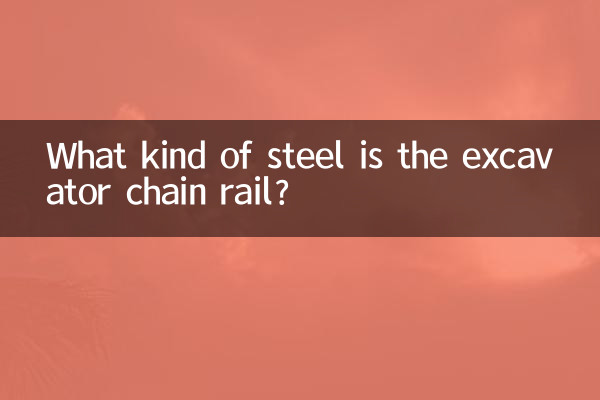What kind of steel is the excavator chain rail made of? ——Analysis of the material secrets of core components of engineering machinery
Among the hot topics on the Internet in the past 10 days, discussions in the field of construction machinery have continued to rise, especially regarding the material selection issue for excavator chain rails (tracks). As the "feet" of the excavator, the durability and performance of the chain rails directly affect the equipment life and operating efficiency. This article will focus on this hot spot and analyze the steel types and characteristics of excavator chain rails through structured data.
1. Core materials of excavator chain rails

Excavator chain rails are usually made of high-strength alloy steel to ensure their wear resistance, impact resistance and fatigue resistance. The following is a comparison of mainstream steel types and properties:
| Steel type | Representative brand | Hardness(HRC) | Tensile strength (MPa) | Main application scenarios |
|---|---|---|---|---|
| medium carbon alloy steel | 40Mn2/40Cr | 28-35 | 800-1000 | Standard chain rail for small and medium-sized excavators |
| High manganese steel | ZGMn13 | 18-22 (initial) 50+ (after work hardening) | ≥800 | Extreme working conditions such as mines |
| Boron steel | 27MnB5 | 35-42 | 1200-1500 | Heavy excavator chain rail section |
2. Comparative analysis of popular steel technologies
In recent industry forums, the discussion on "high manganese steel VS boron steel" has been particularly intense:
| Contrast Dimensions | High manganese steel (ZGMn13) | Boron steel (27MnB5) |
|---|---|---|
| cost | Higher (manganese content 11%-14%) | Lower (boron addition amount 0.0005%-0.003%) |
| Wear resistance | Relying on work hardening, excellent later performance | High initial hardness and stable wear rate |
| Maintenance convenience | Welding is difficult | Better weldability |
3. The latest technological trends in the industry
According to the compilation of industry information in the past 10 days, chain rail steel technology has shown three major trends:
1.Nanotechnology: A new chain rail surface nanocrystalization technology announced by a leading company improves wear resistance by 40%;
2.Composite material application: Carbon fiber reinforced steel matrix composite materials have entered the testing stage, reducing weight by 15% while maintaining strength;
3.Intelligent monitoring system: The "smart link rail" with built-in sensors can transmit wear data in real time, and 23 related patents were added this week.
4. User purchasing guide
Sales data statistics from e-commerce platforms show (last 7 days):
| Chain rail type | Proportion | average unit price | Mainstream brands |
|---|---|---|---|
| Standard type (40Cr) | 58% | 280-350 yuan/section | Shantui, XCMG |
| Enhanced type (27MnB5) | 32% | 400-480 yuan/section | Sany, Doosan |
| Special type (ZGMn13) | 10% | 600-800 yuan/section | Komatsu, Caterpillar |
5. Maintenance points
According to the latest maintenance guidelines issued by the Machinery Industry Association:
1. Check the lubrication condition of the chain rail pin every 50 hours;
2. Under sand and gravel working conditions, rail link debris needs to be cleaned daily;
3. When the wear on one side exceeds 3mm, replacement should be considered.
From the above analysis, it can be seen that the selection of steel for excavator chain rails needs to comprehensively consider factors such as equipment model, working environment, and economy. With the advancement of material science, future chain rail technology will continue to break through performance boundaries and bring more possibilities to the construction machinery industry.

check the details

check the details